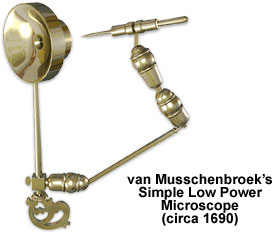van Musschenbroek's Low Power Microscope
Johan Joosten van Musschenbroek designed a brass low power microscope in the late 1600s for tedious work such as dissection, insect observation and categorization, and gross anatomical observations. The microscope illustrated below resides in the Billings Microscope Collection at the National Museum of Health and Medicine at Walter Reed Army Hospital in Washington, D. C.

The design of this single-lens microscope deviated from other van Musschenbroek models and was functionally much simpler than his later microscopes. Several ball-and-socket joints (later referred to as Musschenbroek nuts and attributed to Johan and his brother, Samuel) were used for precise positioning of the specimen holder rod in front of the objective. A pin at the tip of the holder was used to secure samples to the rod. Once the arm was positioned directly in front of the single lens, the focus and specimen position could be adjusted to allow the microscopist to view various aspects of the specimen. The microscope was provided with a broad range of high quality (for the period) "objectives" with magnifications between 8x and 70x.
The instrument illustrated above has the objective mounted in a turned circular cell that is attached to an arm measuring approximately two inches. A second arm is hinged to the first with a ball-and-socket joint with two Musschenbroek nuts terminating in a socket for inserting specimen holders. The model in the Billings collection contains seven objectives and seven specimen rods having ends of various designs. The microscope is signed with the marks of the von Musschenbroeks, which resemble an oil lamp and a set of crossed keys.
BACK TO SIXTEENTH-SEVENTEENTH CENTURY MICROSCOPES
